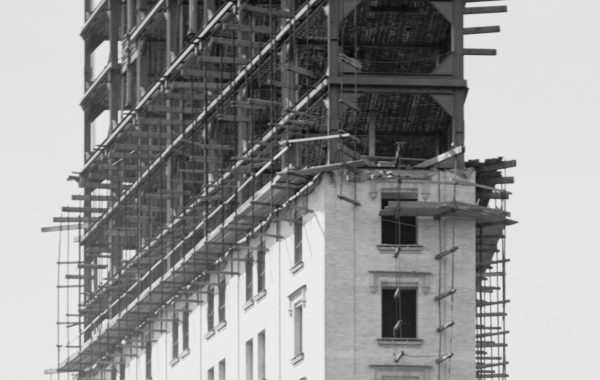The picture above is the answer to a question that people outside the field rarely think about: how do you know where your building actually is?
There are two common ways of thinking about location: using a map (at any scale, up to maps that are detailed to the inch like Sanborn Fire maps) or picturing an actual location by going there. Maps represent the platonic ideal of reality: they don’t show shorelines exactly because sand moves around, they don’t show lots exactly because lots are often not shaped or sized exactly the way the deeds say they should be. The practice of surveying exists to try to relate those two versions of reality – the ideal and the real – by providing maps of small areas that include imperfections. A surveyor’s plan of a lot will show that the angles on two corners of a slightly misshapen lot are 89.9 degrees and on the other two corners are 90.1 degrees, which may not be exactly right (the sides of the lot may be just a little bit curved because the adjoining street isn’t quite straight) but it’s closer than the ideal rectangle shown on the Sanborn.
Now that we’ve got surveyors’ plans, which are more accurate than normal maps, how do we relate them to reality? One of the biggest issues is how to overlay the idealized map on the ground: how do you know where a specific point is? How do you know where your building is? The simple is to make a mark, as indelibly as possible, on the ground that can then be marked on maps. Given two of those points, you can align a map with reality, assuming your lot is small enough that the Earth’s curvature doesn’t interfere. The object above is a surveyor’s mark from the US Coast & Geodetic Survey (click on the picture to expand it and read the engraved text). It’s basically a metal disk nailed to a rock, which is about as low-tech as you can get, but it works.
One last note on technology… The picture above was taken in 1992 using black and white film. (The small spot of brown on the upper left is actual a smudge on the print, not part of the picture proper.) I regularly used black and white in the film/pre-digital-manipulation days because it gave me better results: the grain was smaller than that of the equivalent-speed color film, and so the detail was sharper. This became less important when we started using digital scans of the prints, because it was possible to adjust color to emphasize detail; it became a non-issue when high-resolution digital photography became cost-effective. My past, like that of a lot of other people, is full of hard-won knowledge of techniques that are no longer used.




You must be logged in to post a comment.